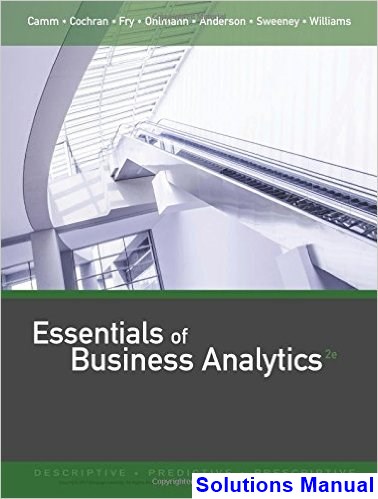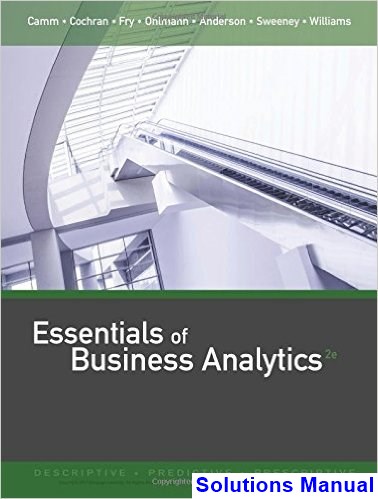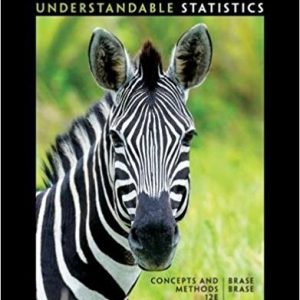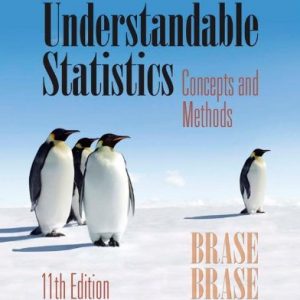This is completed downloadable of Essentials of Business Analytics 2nd Edition Camm Solutions Manual

Product Details:
- ISBN-10 : 1305627733
- ISBN-13 : 978-1305627734
- Author:
ESSENTIALS OF BUSINESS ANALYTICS, 2e provides students the opportunity to build valuable skills that are in high demand by today’s businesses. Excellent examples and visuals help illustrate data and results for each topic. Step-by-step instructions for various software programs help you perform the analyses discussed. You will find practical, relevant problems at a variety of difficulty levels to help you learn and succeed in your course.
Table of Content:
- Chapter 1: Introduction
- 1.1 Decision Making
- 1.2 Business Analytics Defined
- 1.3 A Categorization of Analytical Methods and Models
- Descriptive Analytics
- Predictive Analytics
- Prescriptive Analytics
- 1.4 Big Data
- Volume
- Velocity
- Variety
- Veracity
- 1.5 Business Analytics in Practice
- Financial Analytics
- Human Resource (HR) Analytics
- Marketing Analytics
- Health Care Analytics
- Supply-Chain Analytics
- Analytics for Government and Nonprofits
- Sports Analytics
- Web Analytics
- Summary
- Glossary
- Chapter 2: Descriptive Statistics
- Analytics in Action: U.S. Census Bureau
- 2.1 Overview of Using Data: Definitions and Goals
- 2.2 Types of Data
- Population and Sample Data
- Quantitative and Categorical Data
- Cross-Sectional and Time Series Data
- Sources of Data
- 2.3 Modifying Data in Excel
- Sorting and Filtering Data in Excel
- Conditional Formatting of Data in Excel
- 2.4 Creating Distributions from Data
- Frequency Distributions for Categorical Data
- Relative Frequency and Percent Frequency Distributions
- Frequency Distributions for Quantitative Data
- Histograms
- Cumulative Distributions
- 2.5 Measures of Location
- Mean (Arithmetic Mean)
- Median
- Mode
- Geometric Mean
- 2.6 Measures of Variability
- Range
- Variance
- Standard Deviation
- Coefficient of Variation
- 2.7 Analyzing Distributions
- Percentiles
- Quartiles
- z-Scores
- Empirical Rule
- Identifying Outliers
- Box Plots
- 2.8 Measures of Association Between Two Variables
- Scatter Charts
- Covariance
- Correlation Coefficient
- Summary
- Glossary
- Problems
- Case Problem: Heavenly Chocolates Web Site Transactions
- Appendix 2.1 Creating Box Plots with XLMiner
- Chapter 3: Data Visualization
- Analytics in Action: Cincinnati Zoo & Botanical Garden
- 3.1 Overview of Data Visualization
- Effective Design Techniques
- 3.2 Tables
- Table Design Principles
- Crosstabulation
- PivotTables in Excel
- Recommended PivotTables in Excel
- 3.3 Charts
- Scatter Charts
- Recommended Charts in Excel
- Line Charts
- Bar Charts and Column Charts
- A Note on Pie Charts and Three-Dimensional Charts
- Bubble Charts
- Heat Maps
- Additional Charts for Multiple Variables
- PivotCharts in Excel
- 3.4 Advanced Data Visualization
- Advanced Charts
- Geographic Information Systems Charts
- 3.5 Data Dashboards
- Principles of Effective Data Dashboards
- Applications of Data Dashboards
- Summary
- Glossary
- Problems
- Case Problem: All-Time Movie Box-Office Data
- Appendix 3.1 Creating a Scatter-Chart Matrix and a Parallel-Coordinates Plot with XLMiner
- Chapter 4: Descriptive Data Mining
- Analytics in Action: Advice from a Machine
- 4.1 Data Preparation
- Treatment of Missing Data
- Identification of Outliers and Erroneous Data
- Variable Representation
- 4.2 Cluster Analysis
- Measuring Similarity Between Observations
- Hierarchical Clustering
- k-Means Clustering
- Hierarchical Clustering Versus k-Means Clustering
- 4.3 Association Rules
- Evaluating Association Rules
- Summary
- Glossary
- Problems
- Case Problem: Know Thy Customer
- Appendix 4.1 Hierarchical Clustering with XLMiner
- Appendix 4.2 k-Means Clustering with XLMiner
- Appendix 4.3 Association Rules with XLMiner
- Chapter 5: Probability: An Introduction to Modeling Uncertainty
- Analytics in Action: National Aeronautics and Space Administration
- 5.1 Events and Probabilities
- 5.2 Some Basic Relationships of Probability
- Complement of an Event
- Addition Law
- 5.3 Conditional Probability
- Independent Events
- Multiplication Law
- Bayes’ Theorem
- 5.4 Random Variables
- Discrete Random Variables
- Continuous Random Variables
- 5.5 Discrete Probability Distributions
- Custom Discrete Probability Distribution
- Expected Value and Variance
- Discrete Uniform Probability Distribution
- Binomial Probability Distribution
- Poisson Probability Distribution
- 5.6 Continuous Probability Distributions
- Uniform Probability Distribution
- Triangular Probability Distribution
- Normal Probability Distribution
- Exponential Probability Distribution
- Summary
- Glossary
- Problems
- Case Problem: Hamilton County Judges
- Chapter 6: Statistical Inference
- Analytics in Action: John Morrell & Company
- 6.1 Selecting a Sample
- Sampling from a Finite Population
- Sampling from an Infinite Population
- 6.2 Point Estimation
- Practical Advice
- 6.3 Sampling Distributions
- Sampling Distribution of x
- Sampling Distribution of p
- 6.4 Interval Estimation
- Interval Estimation of the Population Mean
- Interval Estimation of the Population Proportion
- 6.5 Hypothesis Tests
- Developing Null and Alternative Hypotheses
- Type I and Type II Errors
- Hypothesis Test of the Population Mean
- Hypothesis Test of the Population Proportion
- Big Data, Statistical Inference, and Practical Significance
- Summary
- Glossary
- Problems
- Case Problem 1: Young Professional Magazine
- Case Problem 2: Quality Associates, Inc
- Chapter 7: Linear Regression
- Analytics in Action: Alliance Data Systems
- 7.1 Simple Linear Regression Model
- Regression Model
- Estimated Regression Equation
- 7.2 Least Squares Method
- Least Squares Estimates of the Regression Parameters
- Using Excel’s Chart Tools to Compute the Estimated Regression Equation
- 7.3 Assessing the Fit of the Simple Linear Regression Model
- The Sums of Squares
- The Coefficient of Determination
- Using Excel’s Chart Tools to Compute the Coefficient of Determination
- 7.4 The Multiple Regression Model
- Regression Model
- Estimated Multiple Regression Equation
- Least Squares Method and Multiple Regression
- Butler Trucking Company and Multiple Regression
- Using Excel’s Regression Tool to Develop the Estimated Multiple Regression Equation
- 7.5 Inference and Regression
- Conditions Necessary for Valid Inference in the Least Squares Regression Model
- Testing Individual Regression Parameters
- Addressing Nonsignificant Independent Variables
- Multicollinearity
- Inference and Very Large Samples
- 7.6 Categorical Independent Variables
- Butler Trucking Company and Rush Hour
- Interpreting the Parameters
- More Complex Categorical Variables
- 7.7 Modeling Nonlinear Relationships
- Quadratic Regression Models
- Piecewise Linear Regression Models
- Interaction Between Independent Variables
- 7.8 Model Fitting
- Variable Selection Procedures
- Overfitting
- Summary
- Glossary
- Problems
- Case Problem: Alumni Giving
- Appendix 7.1 Regression with XLMiner
- Chapter 8: Time Series Analysis and Forecasting
- Analytics in Action: ACCO Brands
- 8.1 Time Series Patterns
- Horizontal Pattern
- Trend Pattern
- Seasonal Pattern
- Trend and Seasonal Pattern
- Cyclical Pattern
- Identifying Time Series Patterns
- 8.2 Forecast Accuracy
- 8.3 Moving Averages and Exponential Smoothing
- Moving Averages
- Forecast Accuracy
- Exponential Smoothing
- Forecast Accuracy
- 8.4 Using Regression Analysis for Forecasting
- Linear Trend Projection
- Seasonality
- Seasonality Without Trend
- Seasonality with Trend
- Using Regression Analysis as a Causal Forecasting Method
- Combining Causal Variables with Trend and Seasonality Effects
- Considerations in Using Regression in Forecasting
- 8.5 Determining the Best Forecasting Model to Use
- Summary
- Glossary
- Problems
- Case Problem: Forecasting Food and Beverage Sales
- Appendix 8.1 Using Excel Forecast Sheet
- Appendix 8.2 Forecasting with XLMiner
- Chapter 9: Predictive Data Mining
- Analytics in Action: Orbitz
- 9.1 Data Sampling
- 9.2 Data Partitioning
- 9.3 Accuracy Measures
- Evaluating the Classification of Categorical Outcomes
- Evaluating the Estimation of Continuous Outcomes
- 9.4 Logistic Regression
- 9.5 k-Nearest Neighbors
- Classifying Categorical Outcomes with k-Nearest Neighbors
- Estimating Continuous Outcomes with k-Nearest Neighbors
- 9.6 Classification and Regression Trees
- Classifying Categorical Outcomes with a Classification Tree
- Estimating Continuous Outcomes with a Regression Tree
- Ensemble Methods
- Summary
- Glossary
- Problems
- Case Problem: Grey Code Corporation
- Appendix 9.1 Data Partitioning with XLMiner
- Appendix 9.2 Logistic Regression Classification with XLMiner
- Appendix 9.3 k-Nearest Neighbor Classification and Estimation with XLMiner
- Appendix 9.4 Single Classification and Regression Trees with XLMiner
- Appendix 9.5 Random Forests of Classification or Regression Trees with XLMiner
- Chapter 10: Spreadsheet Models
- Analytics in Action: Procter & Gamble
- 10.1 Building Good Spreadsheet Models
- Influence Diagrams
- Building a Mathematical Model
- Spreadsheet Design and Implementing the Model in a Spreadsheet
- 10.2 What-If Analysis
- Data Tables
- Goal Seek
- 10.3 Some Useful Excel Functions for Modeling
- SUM and SUMPRODUCT
- IF and COUNTIF
- VLOOKUP
- 10.4 Auditing Spreadsheet Models
- Trace Precedents and Dependents
- Show Formulas
- Evaluate Formulas
- Error Checking
- Watch Window
- Summary
- Glossary
- Problems
- Case Problem: Retirement Plan
- Chapter 11: Linear Optimization Models
- Analytics in Action: MeadWestvaco Corporation
- 11.1 A Simple Maximization Problem
- Problem Formulation
- Mathematical Model for the Par, Inc. Problem
- 11.2 Solving the Par, Inc. Problem
- The Geometry of the Par, Inc. Problem
- Solving Linear Programs with Excel Solver
- 11.3 A Simple Minimization Problem
- Problem Formulation
- Solution for the M&D Chemicals Problem
- 11.4 Special Cases of Linear Program Outcomes
- Alternative Optimal Solutions
- Infeasibility
- Unbounded
- 11.5 Sensitivity Analysis
- Interpreting Excel Solver Sensitivity Report
- 11.6 General Linear Programming Notation and More Examples
- Investment Portfolio Selection
- Transportation Planning
- Advertising Campaign Planning
- 11.7 Generating an Alternative Optimal Solution for a Linear Program
- Summary
- Glossary
- Problems
- Case Problem: Investment Strategy
- Appendix 11.1 Solving Linear Optimization Models Using Analytic Solver Platform
- Chapter 12: Integer Linear Optimization Models
- Analytics in Action: Petrobras
- 12.1 Types of Integer Linear Optimization Models
- 12.2 Eastborne Realty, An Example of Integer Optimization
- The Geometry of Linear All-Integer Optimization
- 12.3 Solving Integer Optimization Problems with Excel Solver
- A Cautionary Note About Sensitivity Analysis
- 12.4 Applications Involving Binary Variables
- Capital Budgeting
- Fixed Cost
- Bank Location
- Product Design and Market Share Optimization
- 12.5 Modeling Flexibility Provided by Binary Variables
- Multiple-Choice and Mutually Exclusive Constraints
- k Out of n Alternatives Constraint
- Conditional and Corequisite Constraints
- 12.6 Generating Alternatives in Binary Optimization
- Summary
- Glossary
- Problems
- Case Problem: Applecore Children’s Clothing
- Appendix 12.1 Solving Integer Linear Optimization Problems Using Analytic Solver Platform
- Chapter 13 Nonlinear Optimization Models
- Analytics in Action: Intercontinental Hotels
- 13.1 A Production Application: Par, Inc. Revisited
- An Unconstrained Problem
- A Constrained Problem
- Solving Nonlinear Optimization Models Using Excel Solver
- Sensitivity Analysis and Shadow Prices in Nonlinear Models
- 13.2 Local and Global Optima
- Overcoming Local Optima with Excel Solver
- 13.3 A Location Problem
- 13.4 Markowitz Portfolio Model
- 13.5 Forecasting Adoption of a New Product
- Summary
- Glossary
- Problems
- Case Problem: Portfolio Optimization with Transaction Costs
- Appendix 13.1 Solving Nonlinear Optimization Problems with Analytic Solver Platform
- Chapter 14: Monte Carlo Simulation
- Analytics in Action: Cook County Hospital ICU
- 14.1 Risk Analysis for Sanotronics LLC
- Base-Case Scenario
- Worst-Case Scenario
- Best-Case Scenario
- Sanotronics Spreadsheet Model
- Use of Probability Distributions to Represent Random Variables
- Generating Values for Random Variables with Excel
- Executing Simulation Trials with Excel
- Measuring and Analyzing Simulation Output
- 14.2 Simulation Modeling for Land Shark Inc
- Spreadsheet Model for Land Shark
- Generating Values for Land Shark’s Random Variables
- Executing Simulation Trials and Analyzing Output
- 14.3 Simulation Considerations
- Verification and Validation
- Advantages and Disadvantages of Using Simulation
- Summary
- Glossary
- Problems
- Case Problem: Four Corners
- Appendix 14.1 Land Shark Inc. Simulation with Analytic Solver Platform
- Appendix 14.2 Distribution Fitting with Analytic Solver Platform
- Appendix 14.3 Simulation Optimization with Analytic Solver Platform
- Appendix 14.4 Correlating Random Variables with Analytic Solver Platform
- Appendix 14.5 Probability Distributions for Random Variables
- Chapter 15: Decision Analysis
- Analytics in Action: Phytopharm
- 15.1 Problem Formulation
- Payoff Tables
- Decision Trees
- 15.2 Decision Analysis Without Probabilities
- Optimistic Approach
- Conservative Approach
- Minimax Regret Approach
- 15.3 Decision Analysis with Probabilities
- Expected Value Approach
- Risk Analysis
- Sensitivity Analysis
- 15.4 Decision Analysis with Sample Information
- Expected Value of Sample Information
- Expected Value of Perfect Information
- 15.5 Computing Branch Probabilities with Bayes’ Theorem
- 15.6 Utility Theory
- Utility and Decision Analysis
- Utility Functions
- Exponential Utility Function
- Summary
- Glossary
- Problems
- Case Problem: Property Purchase Strategy
- Appendix 15.1 Using Analytic Solver Platform to Create Decision Trees
- APPENDIX A: Basics of Excel
- APPENDIX B: Database Basics with Microsoft Access
- References
- Index





